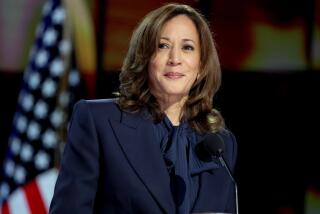Party seeks a Mountain West ascent
DENVER — The Democratic National Convention hasn’t been held in Denver for a century, but when the party nominates Barack Obama here this week it will be returning to a region that is key to its hopes of winning the presidency in November.
Buoyed by their success in state and congressional races, Democrats are hoping the Rocky Mountain West can move solidly into their column during this presidential election, making up for the loss of the party’s former base in the South to the Republicans.
During the primary season, the Democrats allowed Nevada to move up its caucus to January, putting its contest in the same month as the traditional kickoff states of Iowa and New Hampshire. They made a point of selecting the city considered the capital of the Rocky Mountain West for their convention to highlight a willingness to expand from their coastal bases.
Last week the party held conference calls with Senate Majority Leader Harry Reid (D-Nev.) and Sen. Ken Salazar (D-Colo.) to stress the importance of the region and the need to feature Western officials at convention events.
“The road to the White House runs through the West,” said Salazar, who was elected in 2004.
As recently as 2000, all eight Rocky Mountain states featured Republican governors, and their electoral votes usually went to GOP presidential candidates. Now five have Democratic chief executives. Obama has invested significant resources in many of these states and is polling even or ahead of John McCain in Colorado, New Mexico and Nevada, whose total of 19 electoral votes put them as a group on par with battleground states such as Ohio.
“There has been a major political realignment in the Rocky Mountain West in the last seven to eight years,” said Daniel Kemmis, director of the Center for the Rocky Mountain West at the University of Montana. “It’s worked its way up the ballot but has not reached the presidential level.”
That’s because for years, Kemmis said, the party was long willing to sacrifice Western votes to rally its supporters elsewhere.
For example, in 1996 President Clinton won plaudits from environmental groups when he designated huge swaths of southern Utah as a federally protected national monument. Outraged Utah residents, angry at what they saw as a federal intrusion on land management, ousted the Democratic congressman who represented the region.
Observers agree that Westerners are a different breed politically. They tend to be more libertarian and suspicious of the federal government, which is the largest landowner in the region and has a long history of battling with locals over cattle grazing, recreation and development.
“No politician of either party is going to come out here and say, ‘I’m going to raise your taxes and increase social services,’ ” said David Damore, a political science professor at the University of Nevada, Las Vegas.
Western liberals focus on different issues than Democrats in the industrial cities that have historically made up the party’s home turf. They are often more concerned about the environment and lifestyle issues such as growth and transportation than globalization or racial politics.
“Democrats can’t sell New York-style, Massachusetts-style union politics out there,” said Thomas F. Schaller, a political science professor at the University of Maryland, Baltimore County, and author of “Whistling Past Dixie,” which advises Democrats to focus on the West. “They can sell a new environmentally conscious, pragmatic governing style.”
Western Democrats differ from their Eastern counterparts on key issues. Salazar, for example, is a supporter of gun rights, as is Montana’s Democratic governor, Brian Schweitzer. Bill Ritter, Colorado’s governor, opposes abortion rights.
“These guys would be Republicans if they were 500 miles to the east,” said Ken Bickers, a political science professor at the University of Colorado, Boulder.
Conversely, hot-button cultural issues Republicans have used to hammer Democrats in the South and Midwest are less potent in the more live-and-let-live Western United States. Colorado, for example, was the first state to legalize abortion. Nevada already has a law on its books ensuring the procedure will remain legal there should Roe vs. Wade be overturned.
To some skeptics, the idea of a political realignment is overblown because Democrats have long been competitive in Western local and state politics. Dick Wadhams, chairman of the Colorado Republican Party, noted that his state had 24 years of Democratic governors until 1998 and frequently favors one party, then the other.
“This notion that somehow we’re in some unstoppable Democratic trend, I think it’s bunk,” Wadhams said. “Democrats have had a couple of good cycles, but that does not mean it is going to maintain itself in 2008 or 2010 and beyond.”
But analysts say Democrats have benefited from demographic changes in the Rocky Mountain states. The fast-growing region has seen an influx of refugees from coastal states such as California who have brought more liberal attitudes, as well as a surge in immigration by Latinos, who tend to vote for Democrats.
At the presidential level, Colorado, New Mexico, Nevada and Arizona “have gone from being pretty noncompetitive 20 years ago to becoming contestable,” said Ruy Teixeira of the Brookings Institution, coauthor of a new report on Western politics titled “The New Swing Region.”(The other mountain states are Idaho, Montana, Utah and Wyoming.)
Teixeira noted that the growth in the region is fueled by large cities such as Denver or Las Vegas, which a separate Brookings report refers to as “Mountain Megalopolises.” The newcomers tend to be college graduates who back Democrats. The ranks of the most reliable Republican bloc, white non-college graduates, are shrinking.
The choice of Denver for the convention site is a striking piece of partisan ambition. The city has not held a party convention since 1908; the last time Democrats met in a city west of the Mississippi and east of California was their 1928 gathering in St. Louis.
Democratic Party Chairman Howard Dean pledged to expand the party’s geographic base and run a “50-state” campaign instead of pouring resources into only traditional Midwestern battlegrounds. Meeting in Denver is seen as part of his strategy.
“Denver is the perfect, perfect host city for the Democrats,” Schaller said. “Colorado is the great Democratic story of the last two cycles.”
In 1998, Colorado’s only statewide elected Democrat was Salazar, then attorney general. The GOP held the governor’s office and both houses of the legislature. Democrats won back the legislature in 2004 and the governor’s mansion in 2006. President Bush won the state by 4 percentage points in 2004, but Denver voters backed Democrat John F. Kerry by a 40-point margin, equal to that in Chicago and surpassing that in Los Angeles County.
Observers say that in Colorado and other mountain states, Republicans dominated for so long they became overconfident, allowing hungry Democrats to outmaneuver them. Now, with national polls showing the party is favored over Republicans and given Bush’s dismal approval ratings, the Democrats have an opportunity to extend their winning streak and capture the presidency.
“If they can’t do it this year,” said Damore of UNLV, “I don’t know when they will.”
--
--
(BEGIN TEXT OF INFOBOX)
Featured speakers
Monday: Michelle Obama and House Speaker Nancy Pelosi
Tuesday: Sen. Hillary Rodham Clinton and former Virginia Gov. Mark Warner
Wednesday: Sen. Joseph R. Biden Jr. and former President Bill Clinton
Thursday: Sen. Barack Obama, accepting the nomination
Television coverage
The network news channels (ABC, CBS, NBC) will offer nightly coverage of the convention from 7 to 8 o’clock. The cable news channels (MSNBC, CNN, FOX) will broadcast live from Denver and offer round-the-clock coverage.
--
Source: Times research
More to Read
Get the L.A. Times Politics newsletter
Deeply reported insights into legislation, politics and policy from Sacramento, Washington and beyond. In your inbox three times per week.
You may occasionally receive promotional content from the Los Angeles Times.










